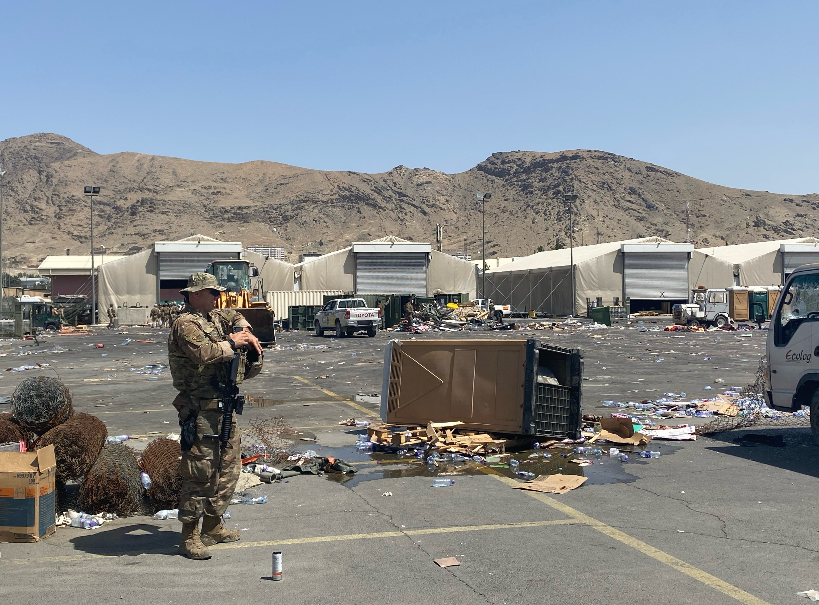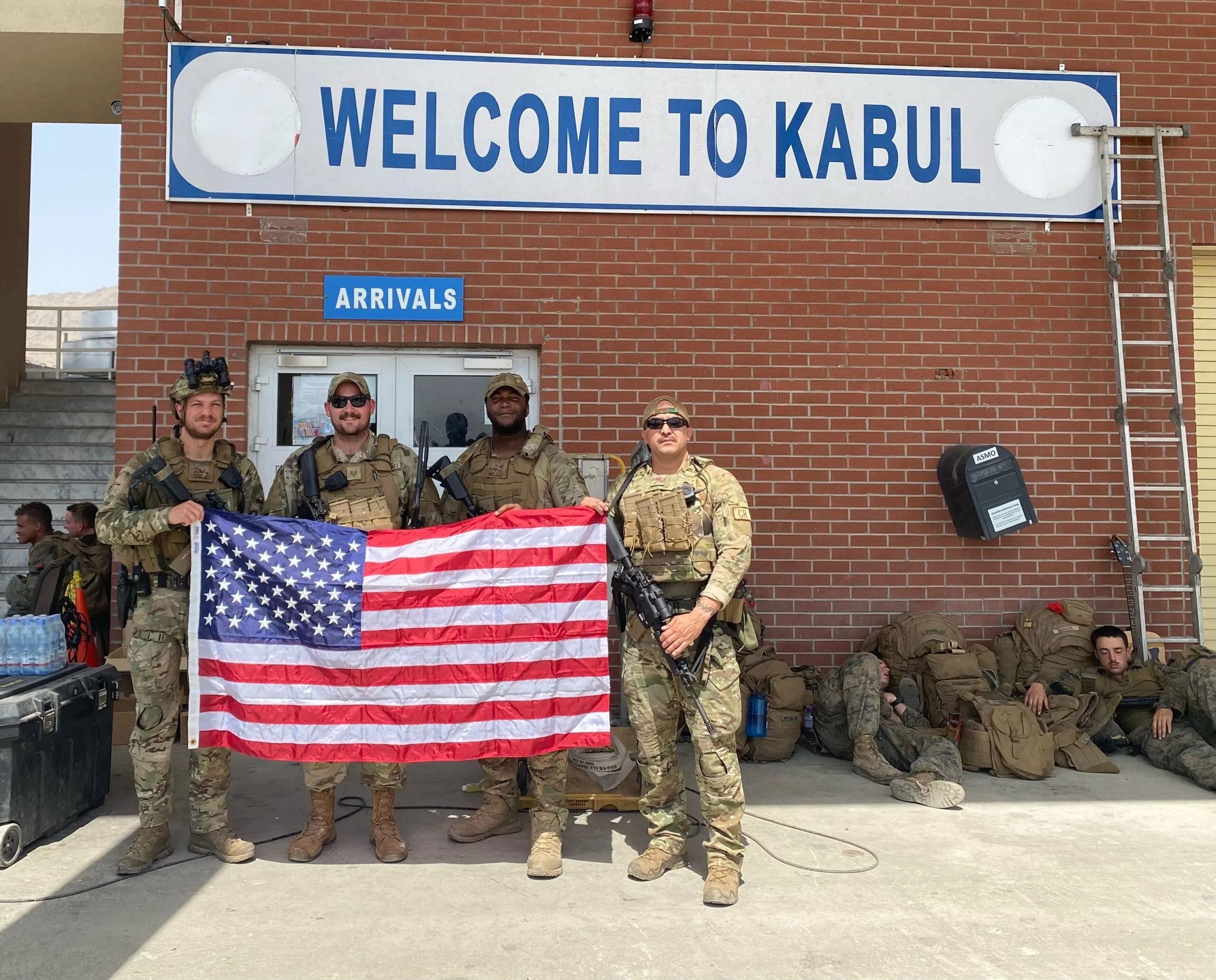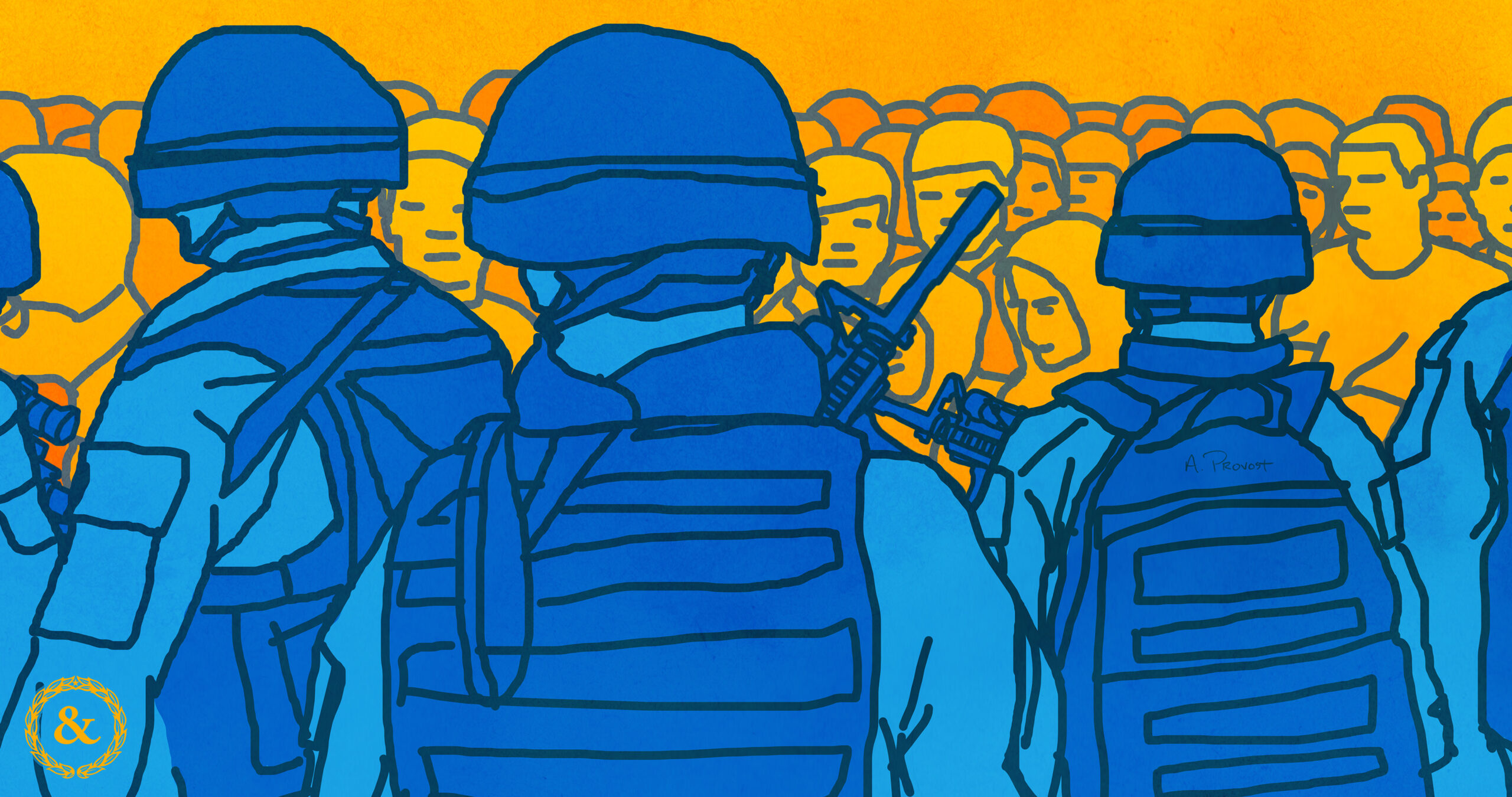It was there, on the airfield in Kabul, Afghanistan on a hot day in the middle of August, that Air Force Master Sgt. Brian Cantu felt certain he was about to die.
Three days ago, Cantu had been eating dinner with his family at his home in New Jersey, but now he and a few other service members were all that stood between a crowd of thousands of terrified Afghan refugees and the operations center for the last U.S. troops in the country.
It was Aug. 16, 2021, about two weeks before the U.S. military was due to leave Afghanistan after twenty years of war there. The Taliban had reasserted control over the nation, and the refugees gathered at Kabul’s Hamid Karzai International Airport (HKIA) were desperate to flee the country. Cantu suspected that they feared the U.S. Air Force C-17 transport jet sitting on the runway at HKIA that day was their last ticket out of Afghanistan, so many of them rushed for it. This was the same day cell phone videos emerged of Afghans clinging to a C-17 as it took off, though that would not happen until later in the day.
“We were sitting in the hangar trying to get comms up when one of the aerial porter guys comes running in and he says ‘they’re coming across the runway!’” Cantu recalled.
Cantu and eight other airmen ran out to join a group of soldiers and Marines who had started to form a line across the grassy median between the runway and the taxiway. The 20 or so service members hoped to keep the Afghans from the aircraft and the operations center on the ramp – a wide expanse of pavement – about 200 or 300 meters behind them.
As a security forces airman, Cantu is trained to keep airfields safe from attack. But there was little he and his fellow service members could do to stop the crowd.
“There were a lot of innocent people just running for their lives, but a big thing in CENTCOM is suicide vests and suicide bombers,” said Cantu, referring to U.S. Central Command, which oversees U.S. military operations in the Middle East. “This is probably one of the scariest parts of my life, because we don’t know what some of these people are holding, so you are on high alert at that point in time.”
Cantu felt “100%” certain he was about to die.
“I thought ‘okay, yeah that’s it,’” he said.

Less than lethal
As a master sergeant, Cantu realized he was the highest-ranking airman on the line. He took charge of the troops around him, telling each airman, soldier and Marine that the rules of engagement were to use only less-than-lethal actions against the refugees. The airman had not received clear instructions beforehand on what the rules of engagement were, so he used his own judgment and experience to make the call on the ground.
In Air Force security forces, there are three criteria that justify the use of deadly force, Cantu explained: opportunity, intent and capability. The crowd before him had the opportunity to inflict harm, but he was not sure about the other two criteria.
“These individuals had the opportunity, but I did not see weapons and I knew everybody was scared,” he said. “Those were the things I relied on to decide on less-than-lethal.”
Subscribe to Task & Purpose Today. Get the latest military news, entertainment, and gear in your inbox daily.
Less-than-lethal actions can include firing warning shots and rifle fighting techniques, where service members use their rifles as a blunt weapon, almost like a club. Cantu went down the line to check each service member remembered that training. Then he waited to see what happened next.
“We were going to hold the line for as long as we could until we could get some more reinforcements,” the airman recalled.
As the crowd approached, Cantu first tried talking to the refugees and waving his hands to get them to stop, but it did not work.
“It got to the point where now you’re going hands-on, pushing people back,” the airman said. “And then down the line you can see some of the other Afghans were getting very physical, swinging, kicking. So that’s when it became essentially hand-to-hand combat.”
“I wasn’t trying to hurt anybody. Initially I was just trying to talk to people, get them to stop,” he added. “But there’s the language barrier and once it became physical it was like ‘all right here’s what it is, I am going to identify my target and swing with my rifle. A buttstroke here, a thrust with the muzzle of my weapon.’ That’s what it was.”

The crowd gradually pushed the line of service members back towards the ramp where the aircraft and the operations center were located. The hand-to-hand fighting seemed to go on forever for Cantu, but he never doubted his choice to stick with less-than-lethal actions.
“Honestly, I never had a second guess, because I did not see weapons and I had trained to the point where I could digest a scenario,” he said. “And the scenario was that these people were scared and they were afraid for their lives. So I did not think they were coming to cause harm.”
It also helped that if somebody brandished a firearm or a knife, then “I knew what I was capable of,” Cantu said.
The refugees were not the only ones afraid for their lives: Cantu said he was “deathly afraid” the entire time. But because of his training and experience, Cantu’s fear did not turn into panic, and he prevented a bad situation from becoming worse.
‘I passed out’
Despite Cantu’s best efforts, the crowd had pushed the line of troops about halfway to the ramp when a unit of Marines arrived, some in armored vehicles firing M2 .50 caliber machine guns over the heads of the crowd in an effort to push them back. Helicopters also flew low overhead, trying to use the dust and pressure from the rotor wash to drive people away.
With reinforcements online, Cantu and the two other security forces airmen, Staff Sgt. Steven Smallcombe and then-Tech Sgt. Antonio Lofton (now a master sergeant) fell back to the trailer that housed the tactical operations center, where they helped fortify the area around it.
Eventually, a Marine joint tactical air controller advised the remaining C-17 to take off, but to do so, the pilot had to taxi the jet through the crowd of Afghans and onto the runway. That was where many people shot cell phone videos of refugees clinging onto the aircraft and falling from it as the jet gained altitude. When the C-17 left, so did the crowd.
“When the civilian population there saw an American flag on the back of a military aircraft, they thought ‘freedom … hey there’s my way out of there,’” said Col. Greg Cyrus, who, as head of the Air Force’s 621st Contingency Response Group, was in charge of HKIA during the most hectic days of the Afghan airlift.
Cyrus had his own near-death experience the night before, when the first group of Afghans and foreigners breached the runway.
“There was a time during that first night where I was counting the number of rounds I had just to make sure that I wasn’t going to be a statistic or end up in some video, if you know what I mean,” he said.
These were intense experiences to come down from. When the airfield was secured after the second breach on Aug. 16, Cantu remembered collapsing from exhaustion.
“I’ll never forget this, there was a mat rolled on the floor, and I didn’t even take my kit off, I just laid down, put my weapon next to it and I passed out,” he recalled.

‘They had a little bit of extra anger’
Just three hours later, Cantu would be up again to help turn a small airport that had been breached twice and had come to a standstill into an evacuation machine helping thousands of people get to safety every day. And even though the airfield was not breached again by large crowds, the tension remained high throughout the operation. Cantu said that if the day the airfield was breached was a 100 on a tension scale of zero to 100, the rest of the operation was about 70.
Part of the reason for the high tension was due to the large number of threats which could arise at any time: nearby residential towers could make great hideouts for snipers, and there was no telling if someone might try to sneak an improvised explosive device in through a breach in the perimeter or into a crowd of evacuees.
On top of that, there was the misery of hundreds of stressed evacuees crammed onto the airfield awaiting flights without enough shade or toilets in the heat of the August sun.
“Just imagine the smell of feces and urine and you’re stepping in it,” Cantu said. “They have nowhere else to go, right? And they’re coming up asking for food, asking for water. It’s just people who want to leave, they’re scared for their lives.”
But there was still room for hope. Cantu remembered seeing some evacuees light up when it was their turn to board a plane.
“You can see the joy in their faces, knowing that they’re going to get a better life, they’re going to get to freedom, they’re going to live,” he said. “It was just amazing.”

The security forces airmen also tried to help out their fellow service members. As part of the 621st Contingency Response Group, Cantu and his colleagues had more direct access to the care packages coming in from families back home.
“We were getting supplies, so we had the luxuries of Gatorade, Red Bull, Monsters, Bangs,” he said. “Smallcombe and I grabbed a whole bunch of snacks, a whole bunch of drinks and we would take them to the gates and give them to the Marines, like ‘hey boom here you go.’ They would love us for that because they’d been jobbing it for however long.”
Smallcombe and Cantu handed out snacks on Aug. 26 at HKIA’s Abbey Gate. About 20 minutes after they left, a suicide bomber attacked a crowd at the gate, killing at least 170 Afghan civilians and 13 U.S. service members. Cantu and his airmen were called back to the operations center to fortify it in case of a wider attack. He was still there when a military chaplain and his aide came by looking for American flags to drape over the caskets of the fallen service members. They were one flag short.
“My whole career I’ve always carried this flag with me everywhere I went: every country, every [temporary duty], every deployment,” Cantu said. “I had it tied to the back of my kit. I cut it off and I gave it to him so they could cover the last casket.”
The airport stopped taking in more evacuees after the suicide bombing, Cantu said. The last few days were spent “rendering inoperable” the vehicles, computers, televisions and other equipment left behind so that the Taliban could not use it. Cantu saw some of the Marines express their feelings about the suicide bombing in how they went about destroying the old equipment with sledgehammers.
“They had a little bit of extra anger that they needed to let loose,” the airman recalled. “They vented a lot, they were pushing over porta-potties, they were doing everything.”

‘You can tell people are changed’
Finally, it was time to go. Cantu and his fellow airmen spent a few days decompressing at Ramstein Air Base, Germany. But now, nearly 18 months after the mission, the memories of Operation Allies Refuge still linger for Cantu and his colleagues.
“I look at it like a thread that you pull and there’s little knots in the thread along the way: each knot is some kind of event or something that sticks in your mind a little bit,” he said.
One of those knots is when Cantu wonders what would have happened if he and his fellow security had more non-lethal equipment with them at HKIA. For example, the Air Force has long range acoustic devices (LRADs) that projects high-decibel sound outwards in a funnel shape to disperse crowds. Though LRADs can cause permanent hearing loss, Cantu thinks they would have been effective at HKIA.
“Anybody within this funnel is done, they essentially drop to their knees and they’ll stop what they’re doing and move away,” Cantu said. “We could have brought that with us and it would have been game over.”
Beyond that, the airman can see some of his comrades are still working through what they experienced during those few weeks in 2021.
“Some of them are having real struggles, some of them have sought out mental health help and some of them have not because they’re afraid of ruining their career, essentially,” he said. “We just try to keep in touch, try to talk with each other, just be there. Those bonds you make with people when you deploy or go through some type of traumatic or significant event together, it’s a bond like no other.”

Cantu himself said it was one of the most intense deployments of his life, despite its short length.
“It was a two-week deployment that felt like it lasted six months, eight months,” he said. “I was more tired from this deployment, when we finally made it back, than any other one.”
The fact that the military evacuated more than 124,000 people in those few weeks gives way to another feeling for Cantu: amazement that they could do all that in such a short amount of time. To highlight that achievement, Air Mobility Command announced in October that the 621st Contingency Response Group will receive the Gallant Unit Citation for their efforts during the Afghan airlift.
Cantu himself received the Bronze Star for his efforts during the airlift, in particular what he did when the airfield was breached on Aug. 16. The airman “demonstrated superior judgment and restraint to avoid civilian casualties, while protecting United States service members and assets from the approaching mob,” read his award citation.
“His exemplary leadership and decisive actions allowed the limited forces on hand to hold the line, buying enough time for coalition forces and reinforcements to arrive,” the citation added.
In the end, pride seems to be a feeling that Cantu and many of his colleagues share when they look back on the chaos of the Afghan airlift.
“You can tell people are changed, they see things differently, they have their own opinions on what we could have done better, what’s wrong or right,” he said. “But at the end of the day, everybody’s proud of the role that they played in getting the mission done.”
The latest on Task & Purpose
- The Navy wiped the ‘Top Gun: Maverick’ director’s camera after he ‘captured something I wasn’t supposed to capture’
- Marine under investigation after viral video showed altercation with hotel staff
- Fighter pilot to receive Navy Cross more than 70 years after classified dogfight with 7 Soviet jets
- 2 Navy commanders fired in one day
- The Marines have a new ship-killing weapons system to counter China
Want to write for Task & Purpose? Click here.

